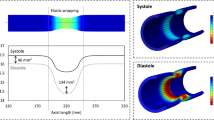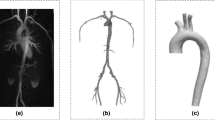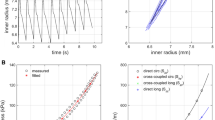Abstract
Elastic arteries are significantly prestretched in an axial direction. This property minimises axial deformations during pressure cycle. Ageing-induced changes in arterial biomechanics, among others, are manifested via a marked decrease in the prestretch. Although this fact is well known, little attention has been paid to the effect of decreased prestretch on mechanical response. Our study presents the results of an analytical simulation of the inflation–extension behaviour of the human abdominal aorta treated as nonlinear, anisotropic, prestrained thin-walled as well as thick-walled tube with closed ends. The constitutive parameters and geometries for 17 aortas adopted from the literature were supplemented with initial axial prestretches obtained from the statistics of 365 autopsy measurements. For each aorta, the inflation–extension response was calculated three times, with the expected value of the initial prestretch and with the upper and lower confidence limit of the initial prestretch derived from the statistics. This approach enabled age-related trends to be evaluated bearing in mind the uncertainty in the prestretch. Despite significantly decreased longitudinal prestretch with age, the biomechanical response of human abdominal aorta changes substantially depending on the initial axial stretch was used. In particular, substituting the upper limit of initial prestretch gave mechanical responses which can be characterised by (1) low variation in axial stretch and (2) high circumferential distensibility during pressurisation, in contrast to the responses obtained for their weakly prestretched counterparts. The simulation also suggested the significant effect of the axial prestretch on the variation of axial stress in the pressure cycle. Finally, the obtained results are in accordance with the hypothesis that circumferential-to-axial stiffness ratio is the quantity relatively constant within this cycle.











Similar content being viewed by others
References
Ahlgren TR, Cinthio M, Persson HW, Lindström K (2012) Different patterns of longitudinal displacement of the common carotid artery wall in healthy humans are stable over a four-month period. Ultrasound Med Biol 38:916–925. doi:10.1016/j.ultrasmedbio.2012.02.005
Åstrand H, Stålhand J, Karlsson J, Karlsson M, Sonesson B, Länne T (2011) In vivo estimation of the contribution of elastin and collagen to the mechanical properties in the human abdominal aorta: effect of age and sex. J Appl Physiol 110:176–187. doi:10.1152/japplphysiol.0 0579.2010
Carta L, Wagenseil JE, Knutsen RH, Mariko B, Faury G, Davis EC et al (2009) Discrete contributions of elastic fiber components to arterial development and mechanical compliance. Arterioscler Thromb Vasc Biol 29:2083–2089. doi:10.1161/ATVBAHA.109.193227
Chen K, Fata B, Einstein DR (2008) Characterization of the highly nonlinear and anisotropic vascular tissues from experimental inflation data: a validation study toward the use of clinical data for in-vivo modeling and analysis. Ann Biomed Eng 36:1668–1680. doi:10.1007/s10439-008-9541-9
Chuong CJ, Fung YC (1986) On residual stresses in arteries. J Biomech Eng 108:189–92
Cinthio M, Ahlgren ÅR, Bergkvist J, Jansson T, Persson HW, Lindström K (2006) Longitudinal movements and resulting shear strain of the arterial wall. Am J Physiol Heart Circ Physiol 291:H394–H402. doi:10.1152/ajpheart.00988.2005
Dobrin PB (1978) Mechanical properties of arteries. Physiol Rev 58:397–460
Dobrin PB, Doyle JM (1970) Vascular smooth muscle and the anisotropy of dog carotid artery. Circ Res 27:105–119
Dobrin PB, Schwarcz TH, Mrkvicka R (1990) Longitudinal retractive force in pressurized dog and human arteries. J Surg Res 48:116–120. doi:10.1016/0022-4804(90)90202-D
Greenwald SE (2007) Ageing of the conduit arteries. J Pathol 211:157–172. doi:10.1002/path.2101
Guccione JM, McCulloch AD, Waldman LK (1991) Passive material properties of intact ventricular myocardium determined from a cylindrical model. J Biomech Eng 113:42–55. doi:10.1115/1.2894084
Han HC, Fung YC (1995) Longitudinal strain of canine and porcine aortas. J Biomech 28:637–641. doi:10.1016/0021-9290(94)00091-H
Holzapfel GA (2000) Nonlinear solid mechanics: a continuum approach for engineering. Wiley, Chichester
Holzapfel GA, Ogden RW (2010a) Constitutive modelling of arteries. Proc Royal Soc A 466:1551–1597. doi:10.1098/rspa.2010.0058
Holzapfel GA, Ogden RW (2010b) Modelling the layer-specific three-dimensional residual stresses in arteries, with an application to the human aorta. J Royal Soc Interface 7:99–787. doi:10.1098/rsif.2009.0357
Holzapfel GA, Gasser TC, Ogden RW (2000) A new constitutive framework for arterial wall mechanics and a comparative study of material models. J Elast 61:1–48. doi:10.1023/A:1010835316564
Horny L, Adamek T, Gultova E, Zitny R, Vesely J, Chlup H, Konvickova S (2011) Correlations between age, prestrain, diameter and atherosclerosis in the male abdominal aorta. J Mech Behav Biomed Mater 4:2128–2132. doi:10.1016/j.jmbbm.2011.07.011
Horny L, Adamek T, Vesely J, Chlup H, Zitny R, Konvickova S (2012a) Age-related distribution of longitudinal pre-strain in abdominal aorta with emphasis on forensic application. Forensic Sci Int 214:18–22. doi:10.1016/j.forsciint.2011.07.007
Horny L, Adamek T, Chlup H, Zitny R (2012b) Age estimation based on a combined arteriosclerotic index. Int J Leg Med 126:321–326. doi:10.1007/s00414-011-0653-7
Horny L, Adamek T, Kulvajtova M (2013a) Analysis of axial prestretch in abdominal aorta with reference to post mortem interval and degree of atherosclerosis. J Mech Behav Biomed Mater (in press). doi:10.1016/j.jmbbm.2013.01.033
Horny L, Adamek T, Zitny R (2013b) Age-related changes in longitudinal prestress in human abdominal aorta. Arch Appl Mech 83:875–888. doi:10.1007/s00419-012-0723-4
Humphrey JD (2002) Cardiovascular solid mechanics: cells, tissues and organs. Springer, New York
Humphrey JD, Eberth JF, Dye WW, Gleason RL (2009) Fundamental role of axial stress in compensatory adaptations by arteries. J Biomech 42:1–8. doi:10.1016/j.jbiomech.2008.11.011
Jackson ZS, Gotlieb AI, Langille BL (2002) Wall tissue remodeling regulates longitudinal tension in arteries. Circ Res 90:918–925. doi:10.1161/01.RES.0000016481.87703.CC
Kalita P, Schaefer R (2008) Mechanical models of artery walls. Arch Comput Methods Eng 15:1–36. doi:10.1007/s11831-007-9015-5
Karatolios K, Wittek A, Nwe TH, Bihari P, Shelke A, Josef D, Schmitz-Rixen T, Geks J, Maisch B, Blase C, Moosdorf R, Vogt S (2013) Method for aortic wall strain measurement with three-dimensional ultrasound speckle tracking and fitted finite element analysis. Ann Thorac Surg (in press). doi:10.1016/j.athoracsur.2013.06.037
Labrosse MR, Beller CJ, Mesana T, Veinot JP (2009) Mechanical behavior of human aortas: experiments, material constants and 3-D finite element modeling including residual stress. J Biomech 42:996–1004. doi:10.1016/j.jbiomech.2009.02.009
Labrosse MR, Gerson ER, Veinot JP, Beller CJ (2013) Mechanical characterization of human aortas from pressurization testing and a paradigm shift for circumferential residual stress. J Mech Behav Biomed Mater 17:44–55. doi:10.1016/j.jmbbm.2012.08.004
Langewouters GJ, Wesseling KH, Goedhard WJA (1984) The static elastic properties of 45 human thoracic and 20 abdominal aortas in vitro and the parameters of a new model. J Biomech 17:425–435
Larsson M, Kremer F, Claus P, Kuznetsova T, Brodin L, D’Hooge J (2011) Ultrasound-based radial and longitudinal strain estimation of the carotid artery: a feasibility study. IEEE Trans Ultrason Ferroelectr Freq Control 58(10):2244–2251. doi:10.1109/TUFFC.2011.2074
Lawrence AR, Gooch KJ (2009) Transmural pressure and axial loading interactively regulate arterial remodeling ex vivo. Am J Physiol Heart Circ Physiol 297:H475–H484. doi:10.1152/ajpheart.00972.2008
Learoyd BM, Taylor MG (1966) Alterations with age in the viscoelastic properties of human arterial walls. Circ Res 18:278–292
Matsumoto T, Hayashi K (1996) Stress and strain distribution in hypertensive and normotensive rat aorta considering residual strain. J Biomech Eng 118:62–71. doi:10.1115/1.2795947
Masson I, Boutouyrie P, Laurent S, Humphrey JD, Zidi M (2008) Characterization of arterial wall mechanical behavior and stresses from human clinical data. J Biomech 41:2618–27. doi:10.1016/j.jbiomech.2008.06.022
Masson I, Beaussier H, Boutouyrie P, Laurent S, Humphrey JD, Zidi M (2011) Carotid artery mechanical properties and stresses quantified using in vivo data from normotensive and hypertensive humans. Biomech Model Mechanobiol 10:867–882. doi:10.1007/s10237-010-0279-6
McEniery CM, Wilkinson IB, Avolio AP (2007) Age, hypertension and arterial function. Clin Exp Pharmacol Physiol 34:665–671. doi:10.1111/j.1440-1681.2007.04657.x
Ogden RW, Saccomandi G (2007) Introducing mesoscopic information into constitutive equations for arterial walls. Biomech Model Mechanobiol 6:333–344. doi:10.1007/s10237-006-0064-8
O’Rourke MF, Hashimoto J (2007) Mechanical factors in arterial aging: a clinical perspective. J Am Coll Cardiol 50:1–13. doi:10.1016/j.jacc.2006.12.050
Rachev A, Greenwald SE (2003) Residual strains in conduit arteries. J Biomech 36:661–70. doi:10.1016/S0021-9290(02)00444-X
Schulze-Bauer CAJ, Holzapfel GA (2003) Determination of constitutive equations for human arteries from clinical data. J Biomech 36:165–169. doi:10.1016/S0021-9290(02)00367-6
Schulze-Bauer CAJ, Morth C, Holzapfel GA (2003) Passive biaxial mechanical response of aged human iliac arteries. J Biomech Eng 125:395–406. doi:10.1115/1.1574331
Shadwick RE (1999) Mechanical design in arteries. J Exp Biol 202:3305–3313
Sommer G, nad Holzapfel GA (2012) 3D constitutive modeling of the biaxial mechanical response of intact and layer-dissected human carotid arteries. J Mech Behav Biomed Mater 5:116–128. doi:10.1016/j.jmbbm.2011.08.013
Sommer G, Regitnig P, Költringer L, Holzapfel GA (2010) Biaxial mechanical properties of intact and layer-disected human carotid arteries at physiological and supraphysiological loadings. Am J Physiol Heart Circ Physiol 298:898–912. doi:10.1152/ajpheart.0 0378.2009
Stålhand J (2009) Determination of human arterial wall parameters from clinical data. Biomech Model Mechanobiol 8:141–148. doi:10.1007/s10237-008-0124-3
Stålhand J, Klarbring A (2005) Aorta in vivo parameter identification using an axial force constraint. Biomech Model Mechanobiol 3:191–199. doi:10.1007/s10237-004-0057-4
Van Loon P, Klip W, Bradley EL (1977) Length-force and volume-pressure relationships of arteries. Biorheology 14:181–201
Wilkins K, Campbell NR, Joffres MR, McAlister FA, Nichol M, Quach S, Johansen HL, Tremblay MS (2010) Blood pressure in canadian adults. Health Reports/Statistics Canada, Canadian Centre for Health Information = Rapports Sur La Santé/Statistique Canada. Centre Canadien d’Information Sur La Santé 21:37–46
Wittek A, Karatolios K, Bihari P, Schmitz-Rixen T, Moosdorf R, Vogt S, Blase C (2013) In vivo determination of elastic properties of the human aorta based on 4D ultrasound data. J Mech Behav Biomed Mater 27:167–183. doi:10.1016/j.jmbbm.2013.03.014
Acknowledgments
This work has been supported by the Czech Technical University in Prague under project SGS13/176/OHK2/3T/12, Czech Ministry of Health project NT 13302, Technology Agency of the Czech Republic in the project TA 01010185, and by the Faculty of Mathematics and Physics of Charles University in Prague project no. 267310.
Author information
Authors and Affiliations
Corresponding author
Rights and permissions
About this article
Cite this article
Horný, L., Netušil, M. & Voňavková, T. Axial prestretch and circumferential distensibility in biomechanics of abdominal aorta. Biomech Model Mechanobiol 13, 783–799 (2014). https://doi.org/10.1007/s10237-013-0534-8
Received:
Accepted:
Published:
Issue Date:
DOI: https://doi.org/10.1007/s10237-013-0534-8




